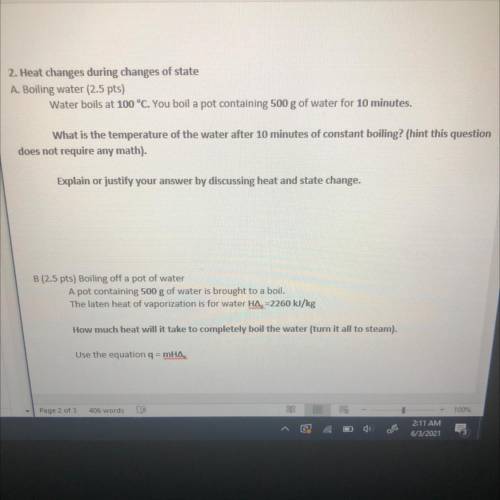2. Heat changes during changes of state
A. Boiling water (2.5 pts)
Water boils at 100 °C. You...

Chemistry, 03.06.2021 14:00 tonimgreen17p6vqjq
2. Heat changes during changes of state
A. Boiling water (2.5 pts)
Water boils at 100 °C. You boil a pot containing 500 g of water for 10 minutes.
What is the temperature of the water after 10 minutes of constant boiling? (hint this question
does not require any math).
Explain or justify your answer by discussing heat and state change.
B (2.5 pts) Boiling off a pot of water
A pot containing 500 g of water is brought to a boil. The later heat of vaporization is for water H=2260 kJ/kg
How much heat will it take to completely boil the water (turn it all to steam) of water is brought to a boil.


Answers: 3


Another question on Chemistry

Chemistry, 21.06.2019 19:10
Imagine that you have produced several versions of lactase, each of which differs from normal lactase by a single amino acid. describe a test that could indirectly determine which of the versions significantly alters the three-dimensional shape of the lactase protein.
Answers: 2

Chemistry, 22.06.2019 00:00
Which of the following methods uses the decay of atomic particles in an object to find its exact age? a. fossil dating b. geologic dating c. radioactive dating d. relative dating
Answers: 1

Chemistry, 22.06.2019 09:00
Look at the spectrums of a star moving towards earth and a motionless star. which of these is a correct inference that can be draw from the observation of the two spectrums? (2 points) the spectrum of a motionless star is difficult to be viewed separately using oridinary telescopes. the spectrum of a motionless star is identical to the spectrum of a star which moves towards earth. the spectrum of a star shifts towards the red region when the star moves towards earth. the spectrum of a star shifts towards the blue region when the star moves towards earth.
Answers: 2

Chemistry, 22.06.2019 16:00
Which process transfers heat from inside earth to its surface? convection currents in mantle pulling away of tectonic plates drawing in of tectonic plates convection currents in crust
Answers: 1
You know the right answer?
Questions


Mathematics, 12.12.2020 16:40

History, 12.12.2020 16:40


Mathematics, 12.12.2020 16:40

Mathematics, 12.12.2020 16:40

Social Studies, 12.12.2020 16:40







Mathematics, 12.12.2020 16:40

Mathematics, 12.12.2020 16:40


Chemistry, 12.12.2020 16:40


Mathematics, 12.12.2020 16:40

Mathematics, 12.12.2020 16:40



